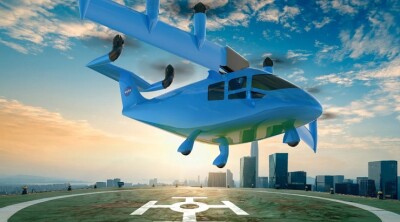Anticipating an annual growth rate of 7.68%, as calculated by the Compound Annual Growth Rate (CAGR) for the period 2024-2029, the Czech Republic has several companies working towards shaping the future of unmanned aircraft airspace.
As an example, Dronetag, the drone identification hardware that provides better visibility of drones in the airspace, was developed in the Czech Republic and continues to expand its reach to new continents. As the only provider offering Remote ID solutions that comply with regulations in the US, and the EU, not only does Dronetag dominate most of the Remote ID market for commercial drones in the United States, but it also successfully entered the Japanese market in early 2024.
In a broader approach, there’s also the Unmanned Aerial Vehicle Alliance (UAVA), a voluntary, non-governmental, non-profit professional association. Its mission is to create prerequisites and optimal conditions for research, development, production, trade, and development of technologies in the field of unmanned aerial industry, by cooperating with authorities and organizations that directly or indirectly relate to the subject of activities of the associated members. Every year, UAVA hosts Dronedge, the largest drone-focused conference in the Czech Republic.
As part of our UAVs Across Europe series, following up are some use cases that showcase how drones are used in the Czech Republic.
Powerline Inspections
ČEPS, the sole Transmission System Operator in the Czech Republic, plays a critical role in maintaining the nation’s power infrastructure. Fully owned by the Czech state and managed by the Ministry of Industry and Trade, ČEPS operates an extensive network that includes 44 substations and nearly 6,000 kilometers of 220kV and 400kV transmission lines. In a recent mission to enhance the efficiency and accuracy of powerline inspections, ČEPS partnered with Hepta Group, deploying cutting-edge drone technology to test its potential against traditional helicopter inspections.
In late 2021, Hepta conducted aerial inspections of a 14.8-kilometer section of 400kV/220kV transmission lines. The project involved capturing high-resolution RGB, infrared, and LiDAR data using drones. A single transmission tower inspection involved an average of 820 detailed photos captured in just 30 minutes, with two drones operating simultaneously. On average, the team photographed seven towers per day, covering 118 kilometers of powerlines in ten days.
Hepta’s analysis team faced a challenging task, managing over 40,000 high-resolution images and identifying more than 850 distinct defects. Thanks to innovative techniques and the Hepta Insights platform, the team completed detailed inspections for each tower in approximately three hours.
This process marked a significant improvement in speed and thoroughness compared to traditional methods, demonstrating that drone-based inspections not only match but often surpass helicopter inspections in efficiency and cost-effectiveness. ČEPS benefited from Hepta’s ability to provide high-resolution, actionable insights that enhance maintenance planning and system reliability. This collaboration underscores the transformative potential of drone technology in modernizing infrastructure management while setting new standards in the power sector.
Non-Destructive Testing Inspections in Power Generation
VZÚ Plzeň, a Czech-based engineering company, is leveraging drone technology to streamline Non-Destructive Testing (NDT) Inspections in power generation.
At a site where engineers had installed steel guiding plates to protect flue ducts, VZÚ was tasked with the inspection of the system’s overall integrity. However, due to ash particles causing abrasion to the structure, the steel plates had already been reduced in thickness, creating a sharp, razor-like environment that made it impossible to reach with rope-access techniques. Using an Elios 3 drone, VZÚ was able to navigate the hazardous, confined space with ease, revealing critical damage such as eroded steel supports that threatened the duct's structural integrity.
In 2023, the company inspected the cooling towers of a power plant. Over 10 days, the team conducted 300 drone flights, assessing approximately 16,000 points across four towers. The detailed analysis included defect identification, localization, and severity assessments, providing plant managers with comprehensive insights. Moreover, the data-rich visualizations showcased the capabilities of drone technology for large-scale industrial inspections, and the benefits it brings to clients, including enhanced safety, reduced downtime, and cost savings by eliminating scaffolding.
“Our journey into the world of drone inspections has not only revolutionized our services but elevated our and clients’ perceptions of safety and efficiency,” Filip Schmidt, drone pilot at VZÚ Plzeň. “As we continue to explore the new possibilities in the power generation space, we remain committed to delivering value, improved safety, and excellence in every mission we undertake.”
Making Roads Safer
Every year, tens of thousands of injuries occur during road accidents in the Czech Republic alone due to speeding, failing to give way, and keeping safe headway. Authorities have a hard time detecting the cause of an accident using traditional methods, but DataFromSky wants to change that with its real-time traffic monitoring solution based on drones and artificial intelligence.
During 2022, the Central Bohemian Police used DataFromSky’s FLOW and TrafficSurvey technologies to extensively measure and analyze road traffic and driving dynamics. By capturing more than 100,000 vehicles from a drone, the company concluded more than 40% of the drivers were found to drive closer than the recommended 2 seconds behind the vehicle in front.
In 2023, at the Central Bohemian Region near the village of Vestec, authorities set up a prevention project leveraging DataFromSky’s technology to measure drivers’ behavior and confront those driving dangerously with the results directly on the spot. The idea was to further test the technology, but also raise public awareness of drone-based traffic monitoring and enforce driving policies by initiating a discussion among drivers about how to drive on the roads.
“We are capable of intervening when we have a driver who doesn't maintain a safe distance, the patrol will stop them a kilometer down the road and directly go through the measurement protocol,” said Petr Dvorak, Head of Aerial Intelligence at DataFromSky. “The experience is quite significant, as in the Central Bohemian Region, there are over a hundred traffic accidents daily. Unfortunately, the number of traffic accidents is increasing, and one of the causes is precisely speed and failure to maintain a safe distance. The evaluation shows that about 62% of all measured drivers maintained a two-second distance, which is recommended but the rest did not, and three percent of drivers had a distance of less than half a second, which wouldn't be enough to react to sudden critical situations in time.”
















Comments